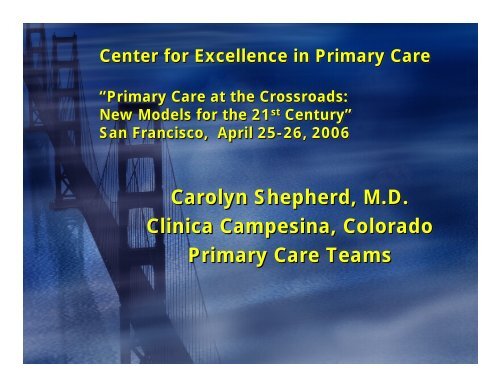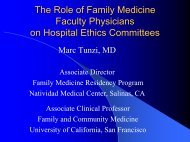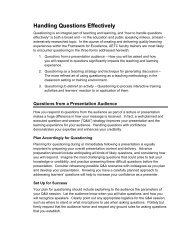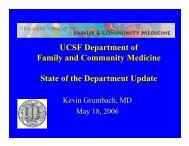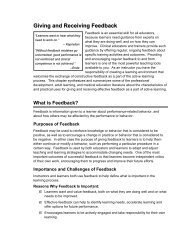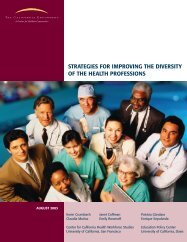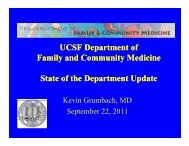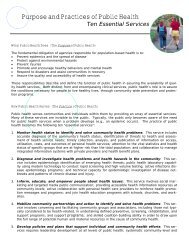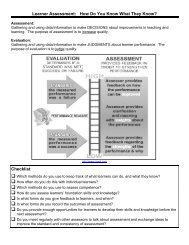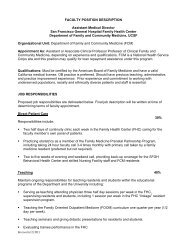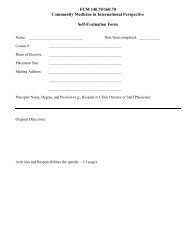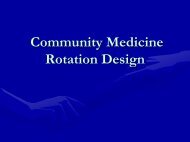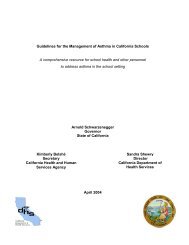Powerpoint Slides - Family and Community Medicine
Powerpoint Slides - Family and Community Medicine
Powerpoint Slides - Family and Community Medicine
You also want an ePaper? Increase the reach of your titles
YUMPU automatically turns print PDFs into web optimized ePapers that Google loves.
Center for Excellence in Primary Care<br />
“Primary Care at the Crossroads:<br />
New Models for the 21 st Century”<br />
San Francisco, April 25-26, 26, 2006<br />
Carolyn Shepherd, M.D.<br />
Clinica Campesina, Colorado<br />
Primary Care Teams
Clinica Campesina<br />
• Federally Qualified <strong>Community</strong> Health Center<br />
• 29,000 Active Patients<br />
• 70% of our patients are at or below poverty, 70% of<br />
adults have at least one full time job.<br />
• 30% have Medicaid, 68% have no insurance<br />
• We see approximately 2100 patients a week, 100,000<br />
each year, <strong>and</strong> we deliver 1700 women a year<br />
• We have had tremendous growth over the last 5 years<br />
• Primary Care - FP, OB, Peds, MDs, DOs, NPs, PAs
The challenge: : Make our micro-system (pod)<br />
deliver care as a patient centered team.<br />
Clinica’s Organizational Chart<br />
Patients<br />
Pecos Lafayette Thornton<br />
Directors<br />
Executive<br />
Team<br />
BOD<br />
Patients
Micro-system Approach<br />
“Power to the Pods”<br />
• Continuity is “king” for staying patient<br />
centered. Maximize at each interaction.<br />
• We strive to have every patient care<br />
service available on the pod.<br />
• Team members are collocated to<br />
facilitate information sharing <strong>and</strong><br />
seamless h<strong>and</strong>offs.<br />
• Every team member has the opportunity<br />
to be the resource person for the patient.
Who is on the pod<br />
• 3 FTE of provider time<br />
• 3 Medical Assistants<br />
• 1 RN or LPN<br />
• 3 office techs (2 front desk, 1<br />
medical records)<br />
• 1 case manager<br />
• Services the pods share: referral<br />
case manager, LCSW, office<br />
manager, financial screening
Collocation<br />
• Picture of the co location
System Design: Huddle
System Design<br />
• Employ the Chronic Care Model to<br />
improve care to patients with<br />
chronic illnesses <strong>and</strong> to provide<br />
prevention interventions<br />
• Registries to facilitate population<br />
management<br />
• Alternative visits (i.e. group visits)<br />
very effective with our patients<br />
• Staff roles change significantly<br />
within the pod
Impact of the innovation<br />
• Continuity<br />
• 90% of well care is with the PCP<br />
• 77% of acute asthma visits are with the<br />
PCP.<br />
• 83% of diabetes care is with the PCP<br />
• Access<br />
• Time to the third next appointment is<br />
under 2 days in 2 of our 3 clinics<br />
• Outcomes<br />
• Improvement in A1cs, % asthmatics on<br />
controller meds, trimester of entry to<br />
care, immunization rates
8.5<br />
8.4<br />
8.3<br />
8.2<br />
8.1<br />
8.0<br />
7.9<br />
7.8<br />
7.7<br />
7.6<br />
Outcomes<br />
Trimester of Entry<br />
100%<br />
% 1st Trimester<br />
% 3rd Trimester<br />
80%<br />
60%<br />
40%<br />
20%<br />
0%<br />
32%<br />
41% 41%<br />
62%<br />
38%<br />
46% 42%<br />
50%<br />
12% 9%<br />
4%<br />
9% 4%<br />
8% 11% 7%<br />
41% 45% 49% 58%<br />
50%<br />
62%<br />
63%<br />
66%<br />
14% 15% 12% 10%<br />
13% 10% 10% 8%<br />
1989<br />
1990<br />
1991<br />
1992<br />
1993<br />
1994**<br />
1995<br />
1997<br />
1998<br />
1999<br />
2000<br />
2001<br />
2002<br />
2003<br />
2004<br />
2005<br />
7.9<br />
7.8 7.8<br />
Dec-05<br />
Jan-0 6<br />
8 8<br />
Oct-05<br />
Nov-05<br />
8.1<br />
Sep-05<br />
Pecos-Red<br />
Average A1c<br />
8.2<br />
8.1<br />
8<br />
7.9<br />
Jul-05<br />
Aug-05<br />
May-05<br />
Jun-0 5<br />
Month<br />
8.1<br />
Apr-05<br />
8.3 8.3<br />
Feb-05<br />
Mar-05<br />
Jan-0 5<br />
Percentage<br />
Percent of Preg nant<br />
100%<br />
90%<br />
Persistant Asthma on Controller Meds<br />
80%<br />
70%<br />
60%<br />
50%<br />
40%<br />
30%<br />
20%<br />
10%<br />
0%<br />
9/1/2003<br />
11/1/2003<br />
1/1/2004<br />
3/1/2004<br />
5/1/2004<br />
7/1/2004<br />
9/1/2004<br />
11/1/2004<br />
1/1/2005<br />
3/1/2005<br />
5/1/2005<br />
7/1/2005<br />
9/1/2005<br />
11/1/2005<br />
100<br />
90<br />
80<br />
70<br />
60<br />
50<br />
40<br />
30<br />
20<br />
10<br />
0<br />
1yr 3222<br />
Missed O<br />
2 yr 43133<br />
Missed O<br />
Lafayette Pecos Thornton Organization<br />
O ct 2005<br />
Apr 2005<br />
O ct 2004<br />
Apr 2004<br />
Thornton<br />
O ct 2003<br />
Apr 2003<br />
O ct 2002<br />
Apr 2002<br />
O ct 2001<br />
Apr 2001<br />
Aug 2000<br />
Apr 2000<br />
%
Impact of the innovation<br />
• Clinicians initially very uneasy about<br />
collocation<br />
• Improved efficiency by 21%<br />
• More growth than if we had paid for<br />
an additional pod<br />
• No provider would return to our old<br />
process <strong>and</strong> structural design<br />
• Significant decrease in top of the<br />
line turnover
Barriers to Success<br />
• Dem<strong>and</strong> is growing<br />
• Lack of a health care SYSTEM<br />
• Specialty care<br />
• Hospital services<br />
• Medicaid reform<br />
• Primary care clinicians<br />
• NHSC rural focus
Key Lessons Learned<br />
• 1. Care for the underserved is complex.<br />
That relationship is also the most<br />
rewarding part of working in safety net.<br />
• 2. Share with all staff the opportunity to<br />
help patients.<br />
• 3. Collocation is critical to improve<br />
efficiency <strong>and</strong> empower staff.<br />
• 4. Measure, celebrate <strong>and</strong> reward the<br />
teams when there is improvement.


